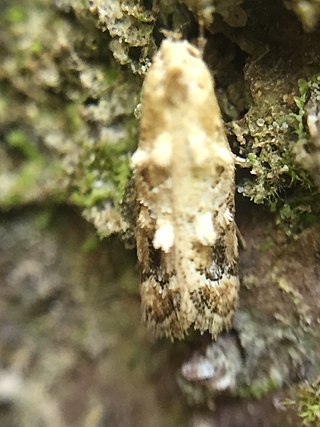Haplovalva is a monotypic moth genus in the family Gelechiidae erected by Anthonie Johannes Theodorus Janse in 1958. Its only species, Haplovalva ametris, was first described by Edward Meyrick in 1921. It is found in South Africa.
Dichomeris percnacma is a moth in the family Gelechiidae. It was described by Edward Meyrick in 1923. It is found in Peru and Amazonas, Brazil.
Narthecoceros xylodes is a moth in the family Gelechiidae. It was described by Edward Meyrick in 1906. It is found in Sri Lanka.
Autosticha xanthographa is a moth in the family Autostichidae. It was described by Edward Meyrick in 1916. It is found in Sri Lanka.
Carodista paroristis is a moth in the family Lecithoceridae. It was described by Edward Meyrick in 1911. It is found in Sri Lanka.
Lecithocera excaecata is a moth in the family Lecithoceridae. It was described by Edward Meyrick in 1922. It is found on Java in Indonesia.
Homaloxestis turbinata is a moth in the family Lecithoceridae. It was described by Edward Meyrick in 1910. It is found in Assam, India.
Lecithocera macella is a moth in the family Lecithoceridae. It was described by Edward Meyrick in 1918. It is found in southern India.
Torodora oxalea is a moth in the family Lecithoceridae. It was described by Edward Meyrick in 1910. It is found in southern India.
Deltoplastis straminicornis is a moth in the family Lecithoceridae. It was described by Edward Meyrick in 1910. It is found in Sri Lanka.
Epimactis spasmodes is a moth in the family Lecithoceridae. It was described by Edward Meyrick in 1914. It is found in southern India.
Torodora syrphetodes is a moth in the family Lecithoceridae. It was described by Edward Meyrick in 1906. It is found in Sri Lanka.
Lichenaula musica is a moth in the family Xyloryctidae. It was described by Edward Meyrick in 1890. It is found in Australia, where it has been recorded from South Australia, Victoria and Western Australia.
Antaeotricha gymnolopha is a species of moth in the family Depressariidae. It was described by Edward Meyrick in 1925. It is found in Brazil.
Antaeotricha nimbata is a moth in the family Depressariidae. It was described by Edward Meyrick in 1925. It is found in Peru.
Imma nubigena is a moth in the family Immidae. It was described by Edward Meyrick in 1910. It is found on Bali.
Imma halonitis is a moth in the family Immidae. It was described by Edward Meyrick in 1920. It is found in Chennai, India.
Imma synconista is a moth in the family Immidae. It was described by Edward Meyrick in 1918. It is found in Kanara, India.

Trachypepla aspidephora is a species of moth in the family Oecophoridae. It is endemic to New Zealand and has been observed in the North and South Islands. Adults are on the wing from November to March and are attracted to light. The moths can be found resting on tree trunks where their colouration imitates lichens.

Trachypepla importuna is a moth of the family Oecophoridae first described by Edward Meyrick in 1914. It is endemic to New Zealand. Adults have been collected in the North Island in January but the species is regarded as being poorly known.


